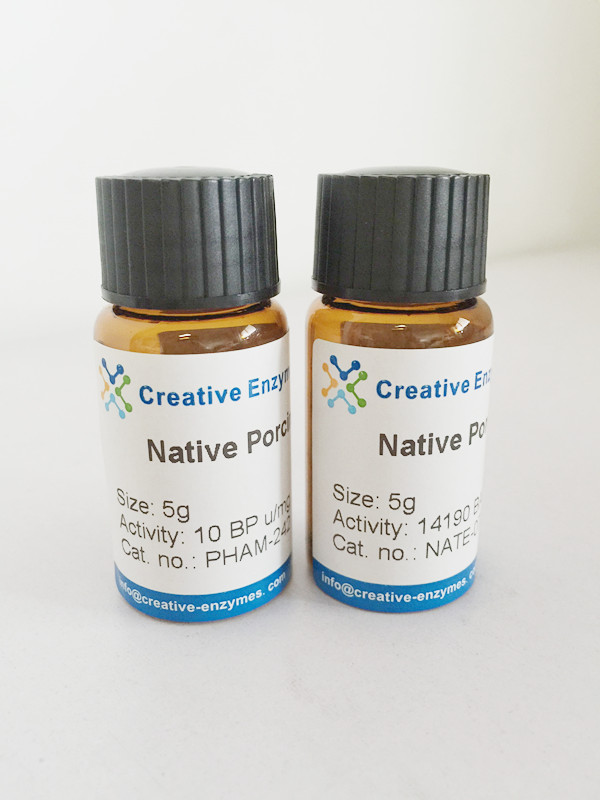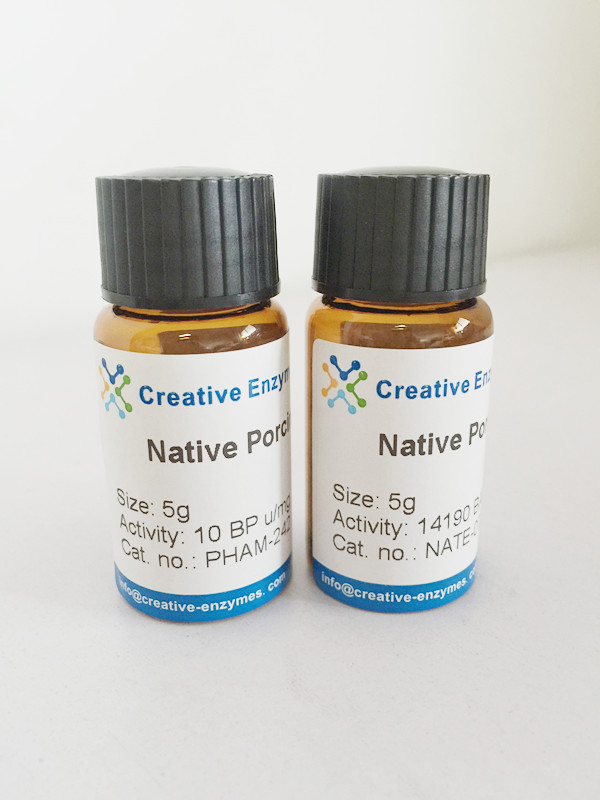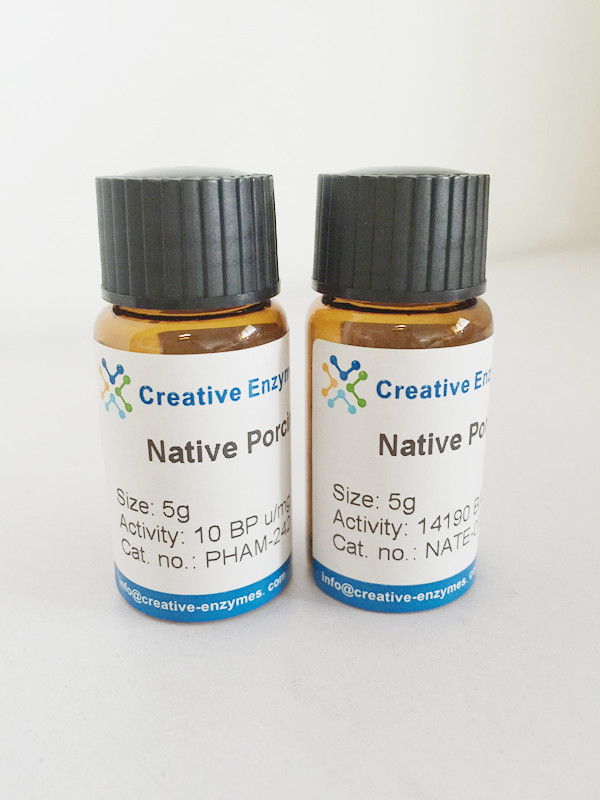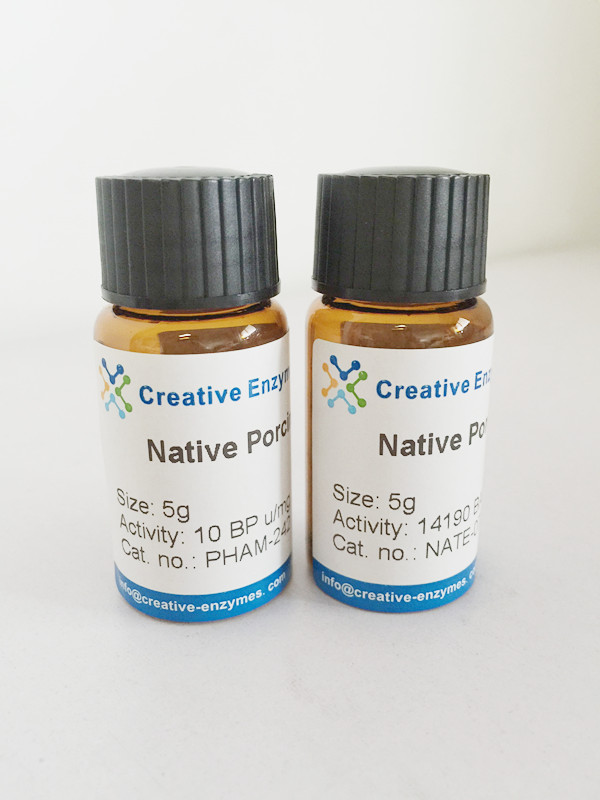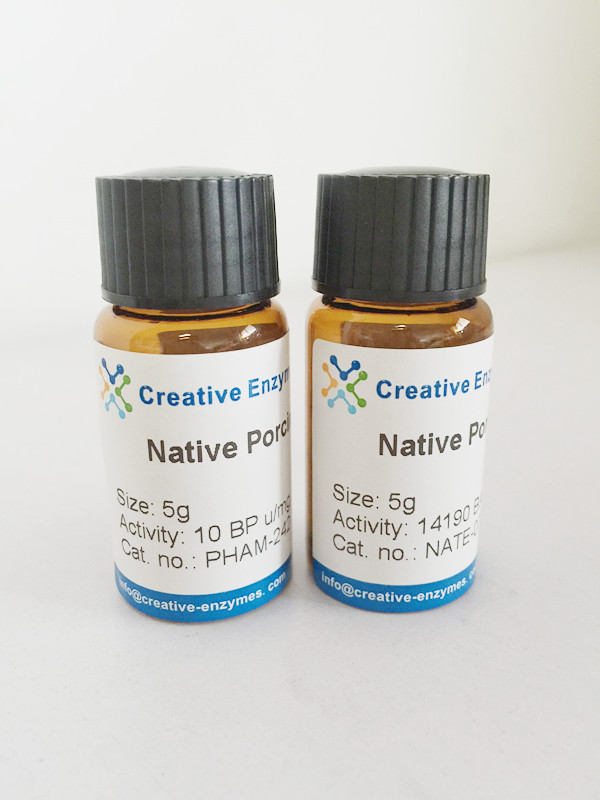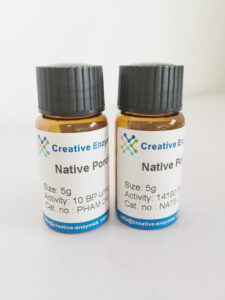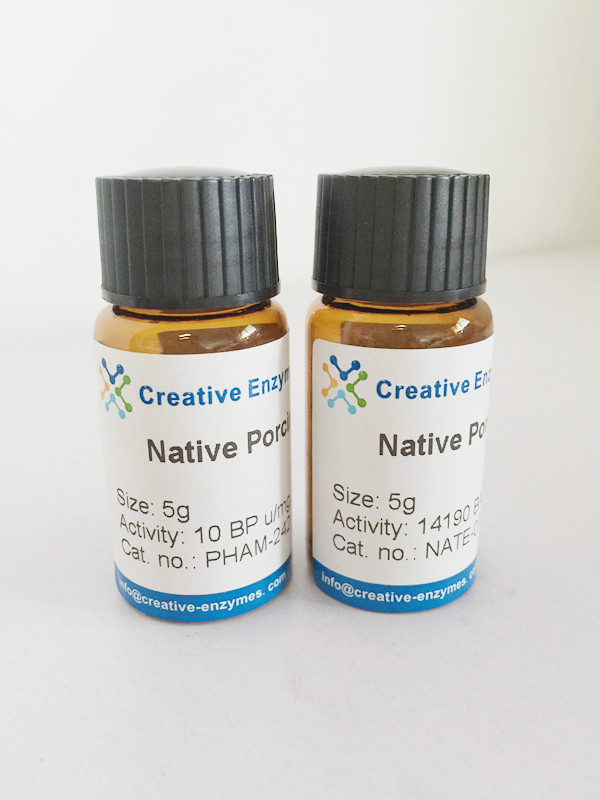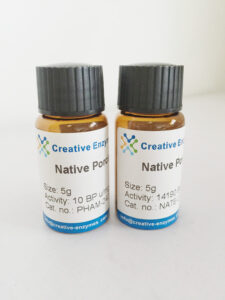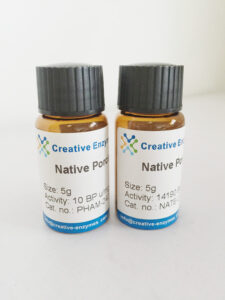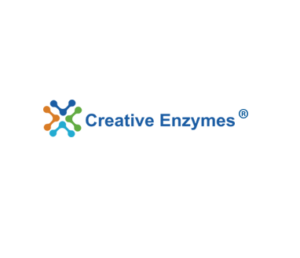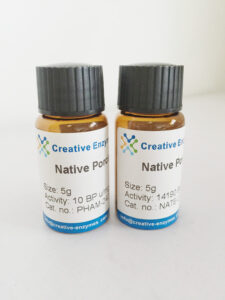Creative Enzymes
Cellulase is a kind of enzyme preparation which produced by cellulase modification. The cellulase of which with high alkaline be used as an ingredient for detergent. In the washing process, cellulase can effectively remove microfiber on fabric for wear. It also can keep cotton fiber fabric with bright color and good smoothness. Therefore, after the […]
More Information
Supplier Page
Creative Enzymes
Lipase is a kind of enzyme preparation produced by aspergillus submerged fermentation. It is also a kind of modified enzyme preparation after DNA recombination. The main activated composition lipase can hydrolyze grease into dihydroxypropyl ester/ diacylglycerol/ glycerin/free fatty acid.
More Information
Supplier Page
Creative Enzymes
A purified bacterial alpha-amylase enzyme that reduces the viscosity of gelatinized starch and produces large amounts of low molecular weight oligosaccharides.
More Information
Supplier Page
Creative Enzymes
An enzyme capable of broad specificity protein hydrolysis over a wide pH range.bromelain is one of the most popular substances to use for meat tenderizing and in pet food production.
More Information
Supplier Page
Creative Enzymes
An enzyme capable of hydrolyzing cellulose. Typically used in food processing, animal feed, dietary supplements, and other food grade ;hydrolyzing cellulose.;
More Information
Supplier Page
Creative Enzymes
Concentrated cellulase enzyme used in laundry and pre-soak detergents to restore the color and the appearance of cotton and cotton-containing garments.
More Information
Supplier Page
Creative Enzymes
Highly concentrated neutral bacterial protease enzyme used in laundry detergents and cleaning products to remove protein containing stains such as grass, blood, mucus, feces and foods.
More Information
Supplier Page
Creative Enzymes
A food-grade, liquid lactase designed to produce lactose-free and reduced lactose dairy products with out altering flavor.
More Information
Supplier Page
Creative Enzymes
Fungal amylase is a liquid amylase preparation fermented by aspergillus. Fungal amylase hydrolyzes starch into maltotriose, dextrose and other oligosaccharides.
More Information
Supplier Page
Creative Enzymes
Glucoamylase adopts fine microorganisms of aspergillus niger extract from its submerged fermentation, no transglucosidase and with high percent conversion. This series products have two kinds-powder and liquid, be widely used in starch sugar,alcohol,brewage,monosodium glutamate,glucose, organic acid, bacteriophage and other industries.
More Information
Supplier Page
Creative Enzymes
A glucoamylase enzyme used to produce extra glucose and limited dextrinization of starch carbohydrates. Results in better crust color and crumb softness.
More Information
Supplier Page
Creative Enzymes
It is a fungal Glucoamylase enzyme derived from a selected strain of Aspergillus niger. The enzyme is a 1, 4- alpha-D-glucan glucohydrolase (E.C. 3.2.1.3) and is commonly referred to as Glucoamylase or Amyloglucosidase. It is an exoamylase that catalyzes the release of successive glucose units from non-reducing ends of dextrin and oligosaccharides chain by hydrolyzing […]
More Information
Supplier Page
Creative Enzymes
The hemicellulase acts on flour pentosans to improve the elasticity of dough gluten/pentosan complexes, enhance dough stability and strength, loaf volume, and crumb structure.
More Information
Supplier Page
Creative Enzymes
An enzyme capable of hydrolyzing sucrose into glucose and fructose. Typically used in manufacturing confectionaries, dietary supplements, and other food grade applications.
More Information
Supplier Page
Creative Enzymes
Amine oxidases (AO) are enzymes that catalyze the oxidation of a wide range of biogenic amines including many neurotransmitters, histamine and xenobiotic amines. There are two classes of amine oxidases: flavin-containing (EC 1.4.3.4) and copper-containing (EC 1.4.3.6). Copper-containing AO act as a disulphide-linked homodimer. They catalyse the oxidation of primary amines to aldehydes, with the […]
More Information
Supplier Page
Creative Enzymes
Glutamine synthetase (GS) (EC 6.3.1.2) is an enzyme that plays an essential role in the metabolism of nitrogen by catalyzing the condensation of glutamate and ammonia to form glutamine: Glutamate + ATP + NH3 → Glutamine + ADP + phosphate. Glutamine Synthetase uses ammonia produced by nitrate reduction, amino acid degradation, and photorespiration. The amide […]
More Information
Supplier Page
Creative Enzymes
In enzymology, a bilirubin oxidase (EC 1.3.3.5) is an enzyme that catalyzes the chemical reaction 2 bilirubin + O2 2 biliverdin + 2 H2O. Thus, the two substrates of this enzyme are bilirubin and O2, whereas its two products are biliverdin and H2O. This enzyme belongs to the family of oxidoreductases, to be specific those […]
More Information
Supplier Page
Creative Enzymes
Glutamate dehydrogenase (GLDH) is an enzyme, present in most microbes and the mitochondria of eukaryotes, as are some of the other enzymes required for urea synthesis, that converts glutamate to α-ketoglutarate, and vice versa. In animals, the produced ammonia is usually used as a substrate in the urea cycle. Typically, the α-ketoglutarate to glutamate reaction […]
More Information
Supplier Page
Creative Enzymes
In enzymology, a L-ascorbate oxidase (EC 1.10.3.3) is an enzyme that catalyzes the chemical reaction2 L-ascorbate + O2 2 dehydroascorbate + 2 H2O. Thus, the two substrates of this enzyme are L-ascorbate and O2, whereas its two products are dehydroascorbate and H2O.
More Information
Supplier Page
Creative Enzymes
In enzymology, a glycerophosphocholine phosphodiesterase (EC 3.1.4.2) is an enzyme that catalyzes the chemical reaction: sn-glycero-3-phosphocholine + H2O choline + sn-glycerol 3-phosphate. Thus, the two substrates of this enzyme are sn-glycero-3-phosphocholine and H2O, whereas its two products are choline and sn-glycerol 3-phosphate.
More Information
Supplier Page
Creative Enzymes
Recombinant Cholesterol Oxidase belongs to the family of oxidoreductases, specifically those acting on the CH-OH group of donor with oxygen as acceptor. This enzyme participates in bile acid biosynthesis.
More Information
Supplier Page
Creative Enzymes
Glucose-6-phosphate dehydrogenase (G6PD or G6PDH) (EC 1.1.1.49) is a cytosolic enzyme that catalyzes the chemical reaction:D-glucose 6-phosphate + NADP+ 6-phospho-D-glucono-1,5-lactone + NADPH + H+. This enzyme is in the pentose phosphate pathway, a metabolic pathway that supplies reducing energy to cells (such as erythrocytes) by maintaining the level of the co-enzyme nicotinamide adenine dinucleotide phosphate […]
More Information
Supplier Page
Creative Enzymes
The activity of glycerol kinase is found widely in nature. In microorganisms GK makes possible the utilization of glycerol as a carbon source. In mammals the enzyme represents a juncture of sugar and fat metabolism; The enzyme is important to the clinical chemist in the determination of glycerol. GK is also useful in the assay […]
More Information
Supplier Page
Creative Enzymes
Creatinine Amidohydrolase catalyzes the hydrolytic reaction converting creatinine to creatine. The enzyme is purified from a microorganism. The molecular size of the enzyme is approximately 175,000. The enzyme is useful for the enzy-matic assay of creatinine when coupled with other related enzymes. Creatinine + H2O → Creatine.
More Information
Supplier Page
Creative Enzymes
Sterol esterase belongs to the family of hydrolases, specifically those acting on carboxylic ester bonds. The systematic name of this enzyme class is steryl-ester acylhydrolase. This enzyme participates in bile acid biosynthesis.
More Information
Supplier Page
Creative Enzymes
Neutral Protease is made from Bacillus subtilis No. 1.398 through fermentation and extraction technique. This product can catalyze protein to hydrolyze into low molecular peptide and amino acid. It is mainly used in the industry of Beer Brewing.
More Information
Supplier Page
Creative Enzymes
An enzyme capable of hydrolyzing protein to peptides and amino acids. Typically used in pet food and flavor manufacture.
More Information
Supplier Page
Papain
| Purity Not Available
Creative Enzymes
An enzyme capable of broad specificity protein hydrolysis over a wide pH range. Typically used as a meat tenderizer and in pet food production.
More Information
Supplier Page
Creative Enzymes
A protease enzyme used in food processing applications to break down and increase the solubility, dispersability, palatability and digestibility of proteins.
More Information
Supplier Page
Creative Enzymes
An effective pullulanase enzyme that hydrolyzes alpha-1,6 glycosidic bonds present in starch side chains and amylopectin.
More Information
Supplier Page
Creative Enzymes
Creative Enzymes
It is a starch-hydrolyzing alpha-amylase with high heat and pH stability derived from a selected strain of Bacillus licheniformis. The enzyme is an endo-amylase that randomly hydrolyses alpha-1, 4-glucosidic bonds to reduce the viscosity of gelatinized starch, producing soluble dextrin’s and oligosaccharides.
More Information
Supplier Page
Creative Enzymes
It is a triacylglycerol lipase enzyme produced by the controlled fermentation of Candida rugosa,suitable for processing dairy fats and oils.
More Information
Supplier Page
Trypsin
| Purity Not Available
Creative Enzymes
[Source]: porcine pancreas (or bovine pancreas) [Molecular weight] :~23.3KDa [Structure features]: folding single-chain (alkalescence) [Nature]: As a protein enzyme, a type of serine proteases, specialized hydrolysis carboxyl terminal is peptide linkage of alkaline amino acid.
More Information
Supplier Page
Creative Enzymes
Creative Enzymes
It is a Xylan hydrolyzing Xylanase enzyme with heat and pH stability derived from a selected strain of Aspergillus. Xylans are polysaccharides composed of β-1, 4- linked Xylopyranose units. They are one of the major constituents of plant cell walls and account for more than 30 % of the dry weight of terrestrial plants. The […]
More Information
Supplier Page
α amylase
| Purity Not Available
Creative Enzymes
α-Amylase isolated from porcine pancreas is a glycoprotein.2 It is a single polypeptide chain of approximately 475 residues containing 2 SH groups and four disulfide bridges and a tightly bound Ca2+ necessary for stability.3,4 Chloride ions are necessary for activity and stability5 The pH range for activity is 5.5 to 8.0, with the pH optimum […]
More Information
Supplier Page
Creative Enzymes
An alpha-acetolactate decarboxylase that bypasses production of diacetyl, converting alpha-acetolactate to acetoin, which reduces maturation time and improves taste, color and aroma.
More Information
Supplier Page
Creative Enzymes
Creative Enzymes
An alpha-amylase enzyme used to produce maltose and dextrins that improve fermentation, baking volume, crumb structure and softness.
More Information
Supplier Page








